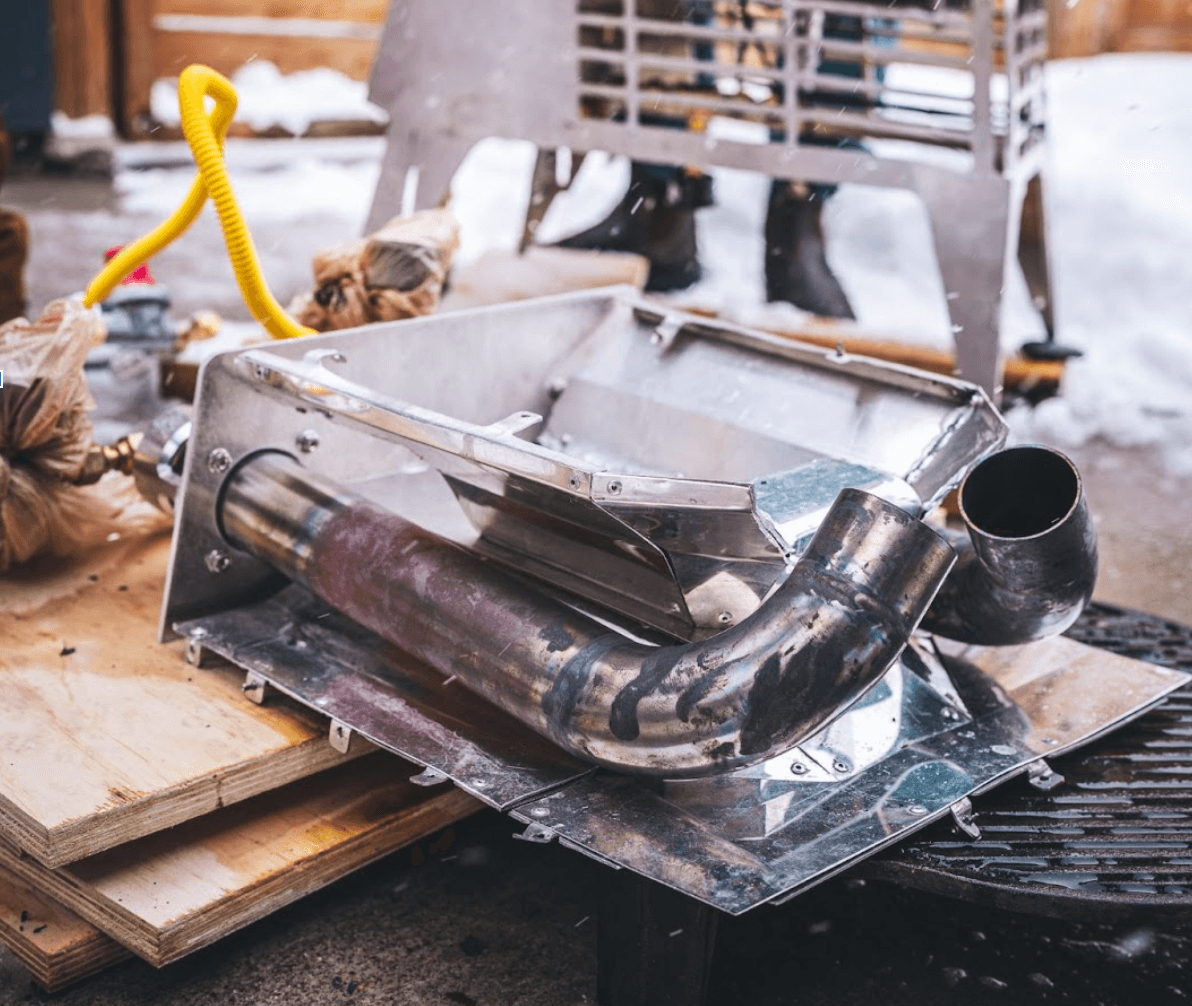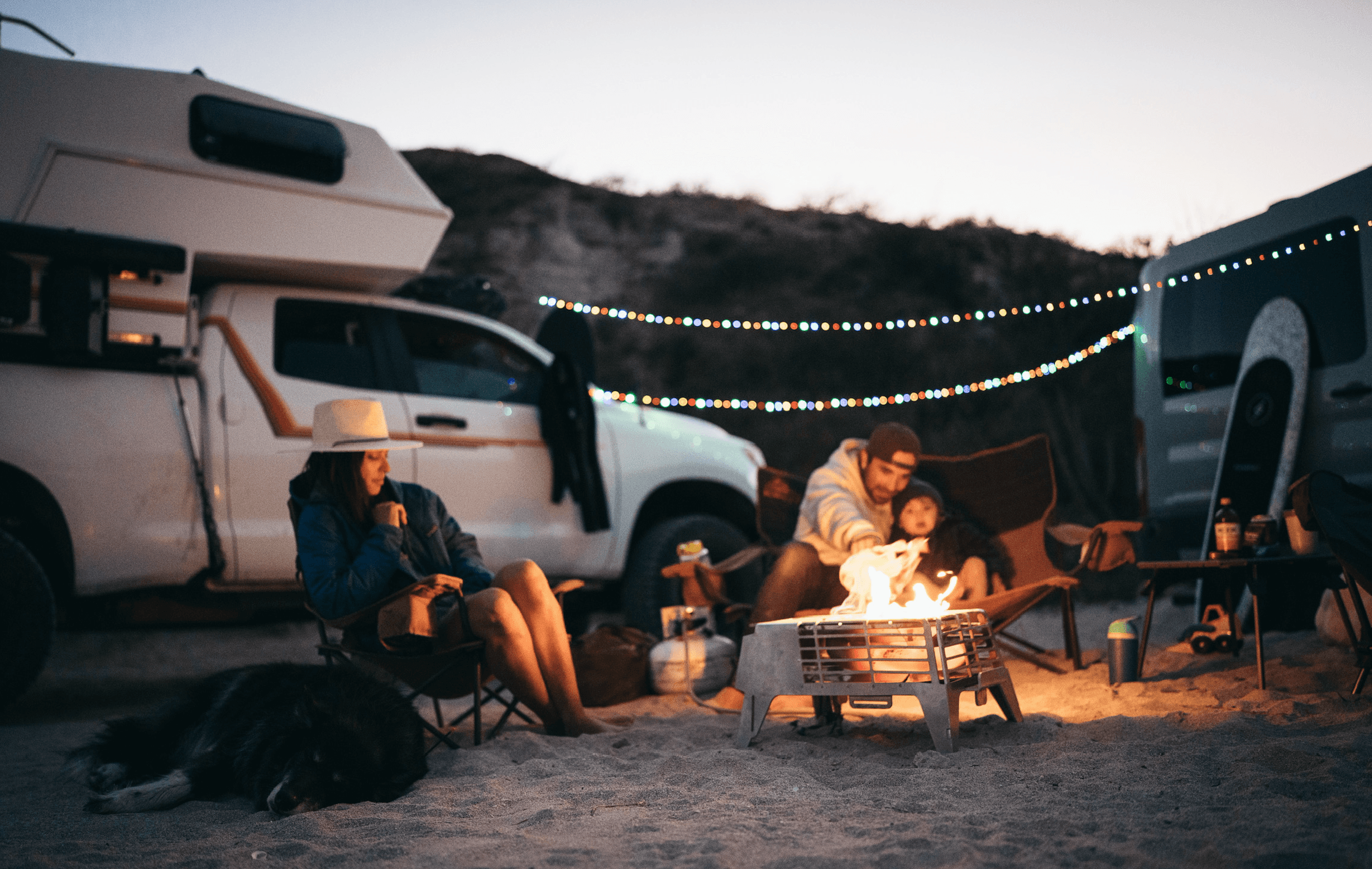Howdy folks and welcome back to the campfire! But take a few steps back. Seriously. This thigh melter just got even more melty.
How? Check out the the BRAND NEW Twin Jet configuration of our BarCoal technology 🛩️🛩️

[You’ll have to excuse how it looks. By now this is a very chopped-apart and frankensteined prototype.]
What does Twin Jet mean?
For months we’d been struggling to get all three sides of the horseshoe-shaped BarCoal to consistently crank out thigh-melting heat. After hundreds of painstaking tweaks, only Sides 1 and 2 were keeping us toasty every time. Side 3 wasn’t always pulling its weight – a real problem when we had six people trying to stay social and warm out in Baja’s winter wind.
Fortunately, we had a solution in our back pocket. Instead of trying to pull the heat all the way down a long and twisting tube, we decided to run two burners at once on two shorter, straighter tubes.

The result? All three sides are now scorching hot at the target temp of 1200ºF, and that has made a MASSIVE difference in keeping us warm.

Testing a propane fire pit in extreme conditions
First, we spent a few winter nights sitting next to the new Twin Jet BarCoal. We stayed comfy as the air temp dropped to around 20ºF.
A few days later, we were ran precipitation tests to see how it would handle rain. Those tests went well, so we decided to see what the new Twin Jet BarCoal would do to a rain-drenched human. We dumped a pitcher of water down Kelly’s chest on a particularly frigid, snowy day day. And as he stood next to the HOWL, the steam came pouring off him. He was completely dry in about five minutes! 🤌

With that proof of extreme weather utility, it was time to take our testing up a notch. We sought out higher elevations, and we wanted the added stressors of serious cold and wind.
At the base of Arapahoe Basin (10,788 ft.), we ran tests at an air temperature of -9ºF. With that kind of cold, we found the unit provided comfort for no more than three people, since we needed to stay close. It also took a few minutes for the IR heat to stack up and penetrate our multiple layers of clothing. But once it did, it felt really good.
In this test, we also found that the Twin Jet BarCoal is not just figuratively thigh melting. The melting can be literal. Diego was wearing some cheap polyester pants from Costco, and they melted rather quickly under the intensity of the infrared heat. So just like a wood fire, you’ll want to keep flammable and meltable objects at a safe distance.

Can a portable propane fire thaw out a diesel engine block?
Now we want to tell you what happened when we tested in even more extreme conditions up on Berthoud Pass, but first…
***WARNING: NEVER ATTEMPT THE FOLLOWING WITH YOUR HOWL CAMPFIRE, A WOOD FIRE, OR ANY OTHER FIRE. SERIOUS INJURY OR DEATH MAY RESULT. HOWL CAMPFIRES IS NOT RESPONSIBLE FOR YOUR IRRESPONSIBLE BEHAVIOR OR MISUSE OF THIS OR ANY OTHER FIRE!***
At dawn we arrived at Berthoud Pass (11,307ft). The thermometer bottomed out at -26ºF – so cold that a guy who’d camped that night in his van couldn’t get his diesel engine to start. His fuel was completely gelled.
We remembered reading a book on the construction of Alaska’s Dalton Highway. In it were photos of the old WWII diesel trucks they used, each with a wood fire built right underneath the engine block. It was the dead of winter in the far north, and when their trucks wouldn’t start, the guys who built the highway made fires to warm up the engines.
Our country boy brains pondered, “Well, if the HOWL is truly as functional as a wood fire…”
The van guy was game to give it a shot, so we placed the prototype under his engine block, lit it, and let it run for a few minutes. The snow began to melt around it, and that was a good sign. With a turn of the ignition, his rig started right up!

After our battery of extreme conditions testing, there’s one overwhelming conclusion: the performance of the Twin Jet BarCoal is everything we’ve been working to achieve for the last two years.
We knew the technology was capable of producing this kind of heat, it just took a lot longer to get here than we’d anticipated. Finally, here we are 🙌
The improved A-Flame now stands up to wind
In Baja in December, we found the A-Flame to be much more wind affected than we wanted it to be. Strong gusts could even blow it out. It was annoying, and it wasn’t a good replication of the traditional wood fire experience. We wanted to see if we could make it behave more like a wood flame.
The concept was pretty simple: We sunk the burner plate down into a wind-protected basin and covered it with a horizontal windscreen. Then we got to testing and tweaking.
In this configuration, the flame can stay lit in strong winds. Intense gusts make the flame duck down inside the basin, but between gusts, it leaps back above the windscreen to give light to your camp. It’s just like a wood fire, where gusts will cause the flames to duck to the leeward side of a log, while lulls allow the flame to stand back up.
We love having a flame that mimics a wood fire, though we’d argue the HOWL is actually better in the wind, since there are no sparks or embers to burn holes in your stuff or torch the forest.
Here’s a rough prototype during testing, getting blasted at point blank by a leafblower. Our subsequent high-altitude wind tests showed a similar flame sturdiness in high winds.

A home stretch THANK YOU!
We’ve been grinding hard for a long time now, trying to make the first propane fire that’s not a compromise to a wood fire.
It’s a worthy goal, but even now as we’re getting close, there are days when we’re flat worn down. Things don’t go as expected. Problems arise that we couldn’t have imagined. We take one step forward and get pushed back two.
The product development phase that we thought would 6 months is now reaching the 2 year mark. On many days, all we’ve wanted to do is complain and throw things.
But on those days, we’ve learned to read your guys’ feedback, your questions, and your encouragement. It reminds us that we’re not alone in this, that you guys are like us, and that together we really can keep the forest and the campfire alive for future generations.
This may sound cheesy, but it’s true: you guys are very literally carrying us and carrying this project. We’re SO GLAD you’re here.
We’re in the home stretch of product development. Soon we’ll have updates for you on everything from parts sourcing to manufacturing to emissions testing to *YES* when you can actually order one (we’re targeting May 1st).
But for now, we just want to say THANK YOU.
Keep carrying the fire,
– Randall, Kelly, Nicholas, Alex, and Diego




